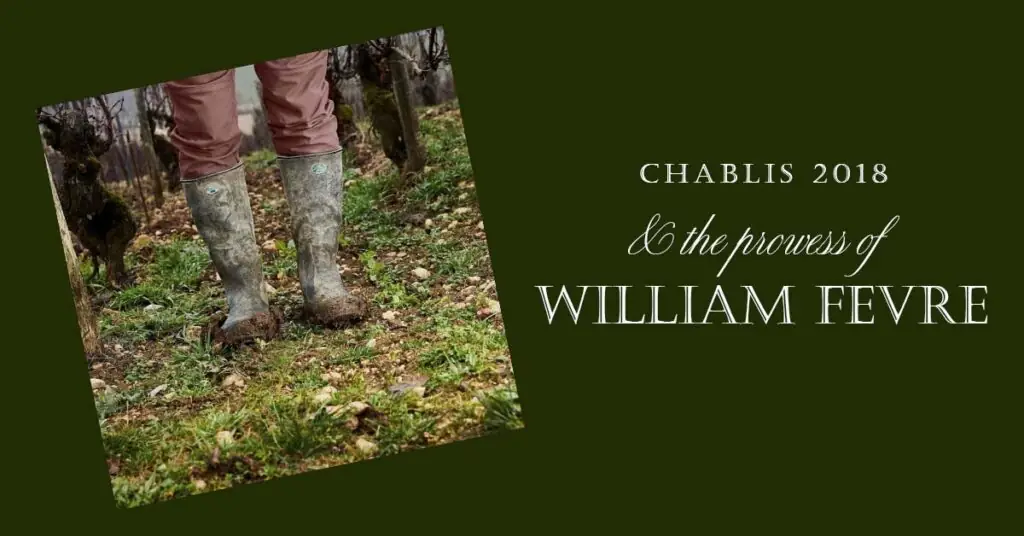Pictured: Les Preuses Grand Cru
In April, thedrinksbusiness.com reported on the rise in Chablis exports to the US by 47% versus 2020. Having taken over the UK, Chablis is, overall, ”the best represented Burgundy appellation on American restaurant wine lists.” With over three million bottles touching down on US shores each year, the back-to-back challenges in 2020 and 2021 growing seasons means less Chablis at a time when demand has never been higher. The 2019 vintage is without question one to go big on before the shortage hits. Cue Domaine William Fèvre and its brilliant set of 2019s.
Dear Reader,
Didier Séguier, cellar master at Domaine William Fèvre, has produced some seriously good Chablis from the 2019 vintage. The smaller crop has resulted in Chablis 2019s of structure and complexity. There may be less wine to go around, but if you can get some, there is real reward in it as these are also wines that will improve with some age.
‘I left my tasting with Didier Séguier wondering if the 2019s might be the best vintage I’ve ever tasted at Domaine William Fèvre. At this address, the vintage’s low yields have translated to wines of remarkable concentration, but Séguier has also achieved levels of cut and tension that are rare in contemporary Chablis.”
William Kelley for Robert Parker’s Wine Advocate (RP)
The impressive size and quality of the vineyard holdings of William Fèvre have over the years always been supported and backed by the powerful and respected Maisons & Domaines Henriot. This has allowed the Domaine the means to produce even better wine from their already highly coveted holdings. All 78 hectares belonging to William Fèvre are now farmed organically, and no shortcuts are taken in the pursuit of the utmost quality.
Available today are a limited number of mixed cases. The first is dedicated to Premier Cru Chablis and the second to Grand Cru – all from the 2019 vintage and all from this mighty Chablis Domaine.
We suggest buying the former mixed case to enjoy earlier and the latter to forget about in your cellar for at least a few years.

Chablis 1er Cru Vaillons 2019 x 2 bottles
Chablis 1er Cru Vaulorent 2019 x 2 bottles
R 4,770 per case
2019 Chablis 1er Cru Vaillons | 92+ points RP
”The 2019 Chablis 1er Cru Vaillons mingles aromas of crisp yellow orchard fruit and white peach with hints of beeswax and white flowers. Medium to full-bodied, enveloping but incisive, with tangy acids and fine depth at the core, it’s long and saline.”
2019 Chablis 1er Cru Vaulorent | 94+ points RP
”Cropped at a mere 34 hectoliters per hectare, the 2019 Chablis 1er Cru Vaulorent is superb, unwinding in the glass with notes of citrus oil, crisp green orchard fruit, white peach, iodine and pastry cream. Medium to full-bodied, satiny and enveloping, with racy acids and a long, iodine-inflected finish, it’s the most complete premier cru in the range.”
2019 Chablis 1er Cru Montmains | 92+ points RP
”Opening in the glass with notes of citrus oil, crisp green apple, iodine and wet stones, Fèvre’s 2019 Chablis 1er Cru Montmains is medium to full-bodied, layered and concentrated, with incisive acids and chalky grip on the finish. Cropped at 35 hectoliters per hectare, it’s unusually deep and structured this year, and it will reward patience.”

R 9,600 per case
2019 Chablis Grand Cru Les Preuses | 95 points RP
”The 2019 Chablis Grand Cru Les Preuses bursts from the glass with scents of orange oil, warm bread, crisp stone fruits and oyster shell. Medium to full-bodied, elegantly textural and enveloping, yields of only 23 hectoliters per hectare mean that it’s immensely concentrated, with racy acids and a long, pungently intense finish.”
2019 Chablis Grand Cru Les Clos | 96 points RP
”The 2019 Chablis Grand Cru Les Clos has turned out brilliantly, mingling aromas of orange oil, confit citrus and crisp green apple with notes of warm bread, white flowers, oyster shell and anise in an incipiently complex bouquet. Full-bodied, layered and muscular, it’s concentrated and tightly wound, with broad shoulders and huge depth at the core, concluding with a long, electric finish. It was cropped at 25 hectoliters per hectare.”















